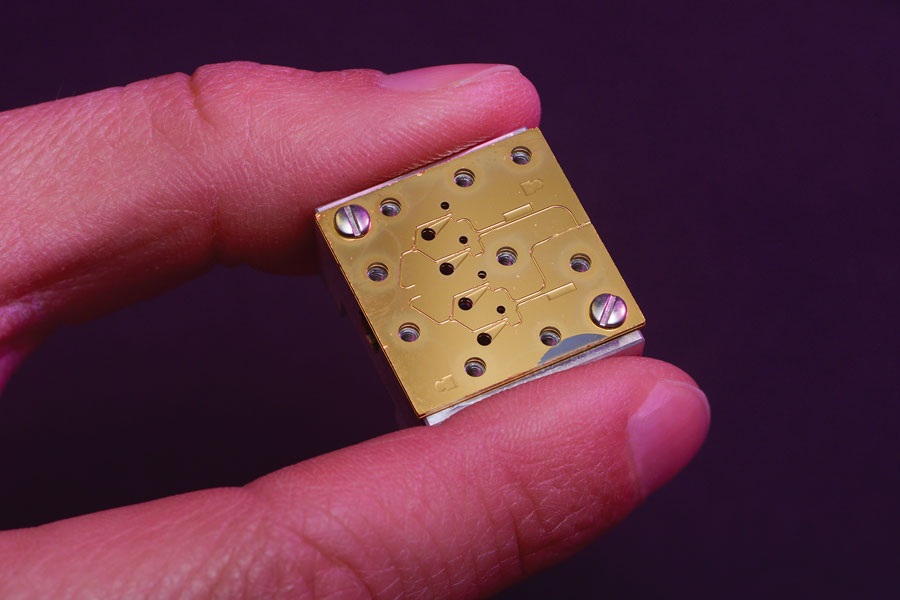Above:
The 500–600-GHz spectrometer front end, with a close-up of the heart of the instrument showing all the silicon micromachined waveguide structures.
Silicon Sculpturing
Silicon Sculpturing for 3-D Miniaturization
Cecile Jung-Kubiak - Maria Alonso - Goutam Chattopadhyay - Sofia Rahiminejad - Jose Siles - Imran Mehdi
Over the last few years, NASA has funded development of super-compact submillimeter-wave instruments for planetary exploration. Submillimeter heterodyne instruments play a critical role in addressing fundamental questions regarding the evolution of galaxies and interstellar clouds, while enhancing our understanding of planet Earth by providing remote sensing data on the higher troposphere and lower stratosphere. However, to make these instruments compatible with small platforms, especially for the study of the outer planets, or enable the development of multi-pixel arrays, it is essential to reduce the mass, power and volume of existing single-pixel heterodyne receivers.
Using newly developed silicon micro-machining technology, we can build low-mass and highly integrated receivers to provide state-of-the-art submillimeter-wave radiometers/spectrometers for orbiter missions to Mars, Venus, Titan, and the Galilean moons. Normally, the mixer and the multiplier chips are packaged in separate waveguide blocks and then connected to form the receiver front end. One way to make supercompact receiver front ends is to etch the waveguide and channel cavities in silicon bulk material as well as integrate the power amplifiers, multiplier, and mixer chip in a single silicon micromachined block.
Instruments using this technology will allow a large number of chemical species, such as water, NO2, N2O, NH3, SO2, H2S, CH4, and HCN, among others, to be detected at concentrations below a part per billion. In exploring planets and their moons from orbit, we will gather data on the thermal structure, dynamics and composition of planetary atmospheres along with surfaces.
In radiometer mode we will measure the polarized thermal emission, revealing aspects of a body’s chemical composition and physical state. The spectrometer will investigate the sources and sinks of trace gases and globally characterize the atmosphere with high spectral, spatial and temporal resolution uniquely available through submillimeter-wave spectroscopy. It will also measure wind speeds, temperature, pressure, and key constituent concentrations in the planetary atmospheres with a higher precision than any other available technology.
The entire PISSARRO instrument is small enough to fit into a shoebox.
+ Larger image
Compact instruments are being designed based on MDL proven technology that can shrink the size and volume of future planetary instruments.
+ Larger image
Thin silicon wafers are patterned and etched to create complex microwave circuits such as mixers and multipliers. These silicon wafers are then vertically integrated to provide 3-D packaging and enabling a compact heterodyne receiver.
+ Larger image




